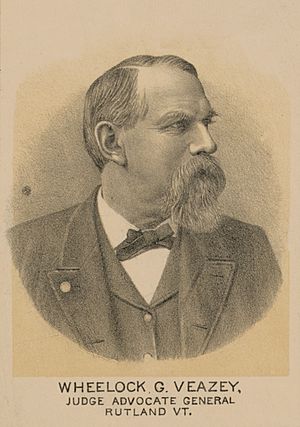Wheelock G. Veazey facts for kids
Quick facts for kids
Wheelock G. Veazey
|
|
|---|---|

Veazey as Judge Advocate General of the Grand Army of the Republic
|
|
| Commander-in-Chief of the Grand Army of the Republic | |
| In office 1890–1891 |
|
| Preceded by | Russell A. Alger |
| Succeeded by | John Palmer |
| Member of the Interstate Commerce Commission | |
| In office 1889–1896 |
|
| Preceded by | Aldace F. Walker |
| Succeeded by | Charles A. Prouty |
| Associate Justice of the Vermont Supreme Court | |
| In office 1879–1889 |
|
| Preceded by | Walter C. Dunton |
| Succeeded by | Loveland Munson |
| Personal details | |
| Born | December 5, 1835 Brentwood, New Hampshire |
| Died | March 22, 1898 (aged 62) Washington, D.C. |
| Resting place | Arlington National Cemetery |
| Education | Dartmouth College |
| Profession | Lawyer Judge |
| Military service | |
| Allegiance | United States of America |
| Branch/service | United States Army Union Army |
| Years of service | 1861–1863 |
| Rank | |
| Commands | 16th Vermont Infantry |
| Battles/wars | American Civil War |
| Awards | Medal of Honor |
Wheelock Graves Veazey (born December 5, 1835 – died March 22, 1898) was an important American lawyer, judge, and government official. He served as a judge on the Vermont Supreme Court. He was also a member of the Interstate Commerce Commission, which helped regulate trade between states. During the American Civil War, he showed great bravery and received the Medal of Honor, the highest military award in the United States.
Early Life and Education
Wheelock Veazey was born in Brentwood, New Hampshire, on December 5, 1835. His parents were Jonathan and Annie Veazey. He went to local public schools and then attended Phillips Exeter Academy. After that, he studied at Dartmouth College, finishing his studies in 1859.
He then decided to become a lawyer. He studied law and graduated from Albany Law School. In December 1860, he was officially allowed to practice law in Vermont. He started his law career in Springfield, Vermont.
A Hero in the Civil War
When the American Civil War began, Wheelock Veazey joined the army as a private. He was part of Company A in the 3rd Vermont Infantry Regiment. He quickly moved up in rank. In May 1861, he became a captain. By August, he was promoted to major and then lieutenant colonel.
On June 22, 1861, he married Julia Beard. In late 1862, he went back to Vermont to help form a new army group. On September 27, he was promoted to colonel and became the leader of the new 16th Vermont Infantry.
Colonel Veazey led his unit bravely at the Battle of Gettysburg on July 3, 1863. Many years later, on September 8, 1891, he received the Medal of Honor for his actions that day. His award citation said he "Rapidly assembled his regiment and charged the enemy's flank; charged front under heavy fire, and charged and destroyed a Confederate brigade, all this with new troops in their first battle." He left the army in 1863 and returned to Vermont.
Life After the War
After the war, Veazey went back to practicing law in Rutland, Vermont. In 1864, he was chosen to be the Reporter of Decisions for the Vermont Supreme Court. This meant he wrote down the court's decisions. He held this job until 1872.
In 1872, he was elected to the Vermont State Senate. The next year, he was appointed as a Registrar in Bankruptcy. In 1876, he was a delegate for the Republican Party at their national meeting. In 1879, he became a judge on the Vermont Supreme Court. He was re-elected to this position every two years until 1889. He also became a trustee for Dartmouth College in 1880.
Colonel Veazey was very active in the Grand Army of the Republic (G.A.R.). This was a group for Union Army veterans. He served as a local leader and then as the head of the Vermont G.A.R. from 1873 to 1875. He later became the Commander-in-Chief of the entire G.A.R. from 1890 to 1891. He was also a member of the Military Order of the Loyal Legion of the United States.
Serving the Country
On August 31, 1889, President Benjamin Harrison appointed Veazey to the Interstate Commerce Commission (ICC). The ICC was a government group that helped regulate railroads and other transportation between states. Veazey took his oath of office on September 10, 1889.
He was reappointed to the ICC for another six-year term by President Grover Cleveland in 1895. He served on the commission until he resigned on December 20, 1896. He stayed in Washington, D.C., and passed away there on March 22, 1898. Wheelock Veazey is buried at Arlington National Cemetery.

